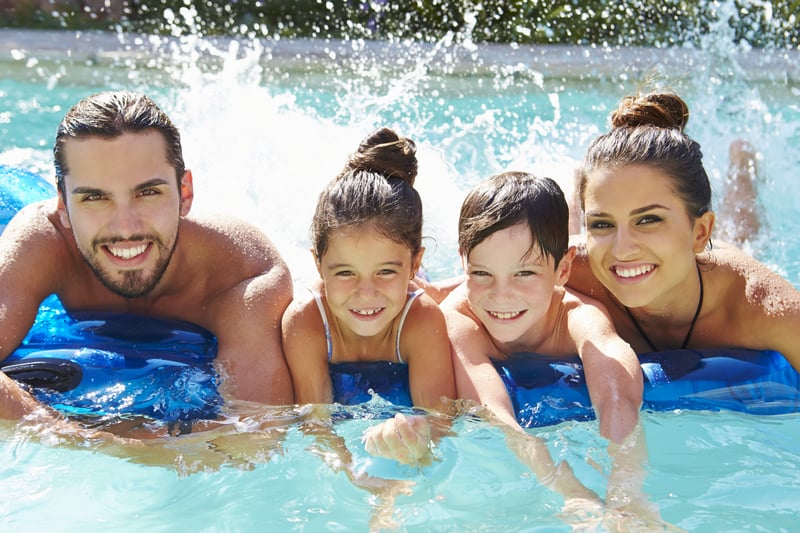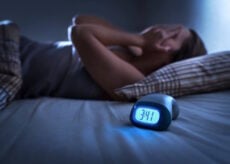13 Summertime Myths You Can Stop Believing ASAP

Have you ever asked yourself, “What do I believe that may not be true?” If you are like most people, over the years, you’ve picked up some beliefs that are supported by less evidence than you may have once thought. Or, they are more nuanced than they appear on the surface. Or, you may simply believe them because they were repeated so many times when you were a kid. Yet, in reality, they’re just false, and you’re free to let them go.
While looking at personal mythology can get quite deep, philosophical, and even identity-altering, don’t worry. We’re not going that deep today. Instead, we’re going to look into some of the most popular summertime myths that many of us still believe — perhaps never even questioned — that are completely (or at least mostly) untrue.
I’m talking about common misconceptions, like “don’t swim for an hour after eating” and “don’t swallow watermelon seeds”. Let’s have some fun as we discover how many of these are actually myths. Some of these may really surprise you once you learn the truth.
13 Summertime Myths You Can Stop Believing In
Myth #1: Swallowing watermelon seeds can make you sick.
You may have also heard they can cause appendicitis or that you’ll grow a watermelon inside you… (thanks to your crazy uncle who just thought it was funny to scare the kids). While watermelon seeds may not be too tasty, they won’t actually cause any harm; they’ll just go through your digestive system and come out the other end.
Just remember to stay hydrated, eat normally, and enjoy all of the wonderful benefits of watermelon if you do swallow a seed or two.
Myth #2: It’s the mayonnaise in the salads that makes you sick.
If you’ve ever gotten sick at a picnic or BBQ, chances are you blamed the mayo-rich potato, macaroni, or chicken salad. And this myth does have roots in truth. If you are eating food made with homemade mayo (i.e., the emulsion of egg yolks with oil), then you definitely want to keep it chilled if it’s going to be out for more than 15 minutes; don’t just leave it sitting in the sun at the end of the buffet line. However, if you’re at an outdoor picnic these days, you’re likely eating store-bought mayonnaise that’s acidic and contains preservatives to keep it safe longer—up to about two hours.
That said, your potato or macaroni salad probably still tastes a lot better when chilled. So, after the meal is served, it’s a good idea to put all of the food back on ice (or in the fridge).
To reduce your risk of getting food poisoning at outdoor parties, your best bet is to make sure you wash your hands well (for at least 20 seconds) with soap and water before eating. And then, avoid touching your face. You’ll also want to make sure your food is well cleaned, and raw meats are kept away from fruits and vegetables. Oh, and don’t forget to clean the grill before you toss on your veggies, steak, or shrimp.
Myth #3: Coolers keep foods cold and safe all day long.
Especially if you have kids or keep your beverages in the same cooler as your food, you could be putting yourself at risk for food poisoning if perishables don’t stay cool. You see, the more often you open the lid, the more the temperature in the cooler can vary. While you can’t always coordinate with everyone in your group, it’s best to try to hand out numerous drinks at a time rather than opening and closing the cooler over and over again.
Properly packing a cooler is also important. It’s all about the layers. Start with a bedding of ice and/or frozen bottles of water (which will help keep your cooler cold and give you some ice-cold water to enjoy later in the day). Then, put your heavier, sturdier packaged items (like other drinks) at the bottom. Add layers of ice or frozen containers throughout the cooler to keep everything chilled longer.
You’ll also want to have some type of organizational plan, so you aren’t opening and digging through all the ice every few minutes. And while you’re in the planning stages, you may also want to pack in some first-aid tools, like frozen aloe vera cubes (just make sure they’re well marked so you don’t accidentally consume them) and vinegar for bug bites, jellyfish stings, or sunburns.
Finally, top your cooler with frozen water bottles; they will help keep the food below chilled but will make the food easier to get to when it’s time to eat. And keep your cooler out of the direct sun to help it stay cool.
Myth #4: You don’t need to wash veggies out of your own yard.
If you have a fruit tree or grow vegetables in your backyard, you may be tempted to just pull your fresh produce directly off the plant and pop it in your mouth. Sure, you know if you’ve sprayed your mini “farm” with any chemicals, fertilizers, or other possible contaminations. Unfortunately, you aren’t the only one with access to your garden. There are animals, as well as birds, that could have defecated on or near your garden. Your neighbor may not be as concerned about fertilizers or pesticides, and if the wind was blowing in the right direction, some overspray may have touched your prized cucumbers or tomatoes.
Fresh-from-the-garden produce absolutely tastes the best. But go ahead and rinse off your produce before you pop it in your mouth…just to be sure.
Myth #5: Hot drinks make you hotter.
Have you ever watched a movie with people sitting around a café drinking hot coffee in the desert and wondered why every drink isn’t served with ice? It almost seems like the hotter the climate, the more likely they are to serve hot tea or coffee. Shouldn’t ice be mandatory?!
While it seems counterintuitive, in hot, dry environments, the hot beverage is actually better at cooling you down. You see, it’s all about sweat. According to research, as long as you’re in a dry environment where your sweat evaporates, you’re more likely to sweat when you consume a hot or warm drink. And as sweat evaporates from your body, you cool down because it increases the body’s heat loss while reducing body heat storage.
If you really want to get your sweat on quickly (to cool off, of course), add some hot, spicy food.
That said, if you are in a hot, humid environment or you’re wearing a lot of clothes, you’ll probably want to go with an iced beverage, as your sweat won’t have a chance to evaporate, and that means the heat from your food or drink won’t be nearly as effective at cooling you down.
Myth #6: Beer is a great rehydration drink after exercise.
How many times do you see folks gathering together at a brewery after a group ride, hike, or run? Many of them will even tell you they’re just enjoying a cold one to rehydrate — maybe even improve their recovery. While enjoying a beer after exercise isn’t necessarily harmful (as long as it’s in moderation) — it does provide electrolytes and carbohydrates — alcohol causes you to lose more fluid than you consume. So, make sure you’re also drinking plenty of water during and after your exercise session to prevent dehydration.
Myth #7: Wait at least 30 minutes after eating before you swim.
Despite the worry and agitation of countless moms, you are not going to cramp up and drown from swimming on a full stomach. Yes, it is true that when you’re digesting food, blood flow moves away from the muscles to get the work done in the gut, but there aren’t any documented cases of people cramping in the pool after eating.
That said, you may be a bit more comfortable if you give your tummy time to rest and digest before hopping back into the pool, and you probably won’t want to start doing laps. However, your muscles won’t start cramping uncontrollably if you decide to get back into the water right after eating.
Myth # 8: Use the side of your hand to dislodge water from your ear after swimming.
If you’re looking for a headache, maybe… but if you want to get the water out, you’re better off tilting your head until your ear is parallel with the ground. Then use the tip of your index or ring finger to gently pull the cuplike spot at the bottom of your ear. Then wiggle your ear until the water begins to drip out and you experience relief.
Myth #9: There’s no need to shower after a swim.
Whether you’re hitting the pool, a lake, or the ocean, you’ll want to make sure you shower after you get out of the water (as well as before you get into the pool). You see, water, as well as sand, is often teeming with bacteria that can irritate the skin or even make you ill—with vomiting, diarrhea, respiratory, and eye infections. Even if you smell the common chlorine smell, it still doesn’t kill all bacteria. (Plus, chlorine can be pretty irritating to the skin.) Please, hit the showers and soap up with clean water when your swim day is done.
Myth #10: Pool water is safe to swallow (due to the chlorine).
Please… don’t! Even a single drink of pool water can be loaded with bacteria, parasites, chemicals, and just plain gross stuff that can lead to infection, diarrhea, nausea, vomiting, and all sorts of ills that can last for weeks.
You’re also likely to find traces of feces as well as gallons of urine in public pools. (Some estimates say up to 20 gallons of urine in a commercial pool.) If your local pool has a strong chlorine smell, it’s probably because the pool water is mixing with urine, which can also make it difficult for people with asthma and other breathing conditions to breathe.
Speaking of urine…
Myth #11: Pee on a jellyfish sting to relieve the pain.
First of all, ewww…. Second of all, ewww… While you may have seen this idea on an old sitcom from the ‘90s, don’t believe it. It’s never been proven to be helpful and may, in fact, make the sting more painful.
Instead, if you are stung by a jellyfish, rinse the area with seawater before soaking a cloth or napkin in a cool vinegar and water solution or baking soda and water solution and press it on the injury for about 30 minutes to help relieve the pain. Then, when you get back to where you can shower, wash it well. And if you have more severe symptoms, like shortness of breath or chest pain, seek immediate medical care.
Myth #12: Once you get a good base tan, the sun is completely safe.
Sadly, there’s no such thing as safe tanning. And there’s no evidence that a “base tan” protects against sunburn, which increases your risk of skin cancer. While getting some sunlight is vital to your health, after about 10 to 15 minutes, it’s time to protect your skin (with a quality sunscreen, clothing, and/or shade) to protect you from burns. Here’s how to properly choose and use sunscreen.
Many of us use only about half or less of the amount of sunscreen we need. If you’re at the beach or pool and your whole body is exposed, you’ll want to make sure you use a full shot-glass worth. And reapply it at least every couple of hours.
Myth #13: Keeping the air conditioning (AC) pumping makes you sick.
On a super-hot day, you may be tempted to crank up the AC and keep it running day and night. We don’t blame you (especially if you live in a hot climate)! That may not be the best idea for your wallet or the environment, and you may want to look at how to put your home on an energy diet, but it isn’t likely to make you sick. And if you are getting the summer sniffles, it may be due to allergies. In that case, it’s time to clean out the filter and make sure the AC is clean.
That said, if you’re in a public environment, such as a gym, restaurant, or mall, and the AC is pumping, it also means that the air is recirculating, so you’re sharing breaths (and potentially illness-causing droplets) with others who have been in that space. And because the AC can be pushing the air around, if someone in the area is sick, it could at least theoretically push their germs further and be more likely to infect others. So, it’s worth assessing your risks to decide for yourself, especially if an illness is going around or it’s cold and flu season.
Now that these myths have been shattered, you may wonder if any of the summertime advice you heard as a kid is true. A lot of is it. For example…
3 Summertime Facts Facts to Adhere To
Truth #1: Avoid a hot shower when sunburned.
If you’ve ever had a sunburn, you likely already discovered that a hot shower is a very bad (and painful) idea. Heat increases inflammation, making your sunburn even more painful. Turn the shower setting to the cool side for some relief. Then pull out the old ice pack and add some soothing aloe to help relieve that sunburn.
Other useful tools to help ease a sunburn include milk and oatmeal, which can help reduce inflammation when applied to the skin. If you have a bathtub available, add two cups of uncooked oatmeal and one cup of whole milk into cool or tepid bathwater. You can also add a tablespoon of honey to the bath. Enjoy a nice soak for at least 5 to 10 minutes before patting your body dry and applying your aloe for even more relief.
Truth #2: Eyes can sunburn too.
This is very true, and you want to ensure you protect your eyes with quality sunglasses that protect against UVA and UVB rays. A wide-brimmed hat helps too if you’ll be spending the day outside. Symptoms of sunburned eyes are very uncomfortable and include blurred vision, pain, redness, tearing, and even vision loss.
Truth #3: Scratching bug bites makes them itch worse.
Indeed, scratching a bug bite (mosquitoes, flies, etc.) releases more histamine, which amplifies itching and swelling, so the bite itches worse or becomes more painful. Instead, remove the stinger first (if there is one), then wash the area with soap and water. Then use an ice cube or cold wet cloth to press into the bite to help reduce the swelling. You may also want to use some baking soda paste, hydrocortisone cream, calamine lotion, or lavender essential oil directly on the bite to help relieve the pain and swelling.
Now that you know the truth about some of the most common summer myths, you can better enjoy all the season has to offer while, hopefully, avoiding some of the hazards. Stay cool and safe out there! And don’t forget to stay hydrated!





 7 Signs Your Body is Seriously Low on Collagen (not just wrinkles)
7 Signs Your Body is Seriously Low on Collagen (not just wrinkles) Health Expert: "Turmeric Doesn't Work (unless...)"
Health Expert: "Turmeric Doesn't Work (unless...)" 3 Warning Signs Your Probiotic Supplement is a Total Waste
3 Warning Signs Your Probiotic Supplement is a Total Waste

